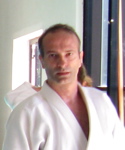For almost 30 years, Aikido has allowed me to evolve and move forward in life. At first I considered practice solely as a body need, a physical need, just like the practice of team sports which I was very familiar with before taking up Aikido. I did not feel ready to meet the requirements of an individual practice that was exposing the body to tremendous pains and strains. The seiza posture, the falls, joint locks, the immobilizations etc. After several years facing difficulties and injuries, my body slowly got used to answering the different situations it was being placed under but more than that, it even took pleasure in moving with a partner. After several painful years of sustaining injuries and facing difficulties, my body learned to adapt and answer to the various solicitations and slowly, it even started to take pleasure in moving with a partner. It is during this journey that the many teachers I met educated me and turned me into what I am now. Thanks to their generous help, I reached the situation which is mine nowadays. I want to humbly thank here all these professors who helped me, in particular Christian Tissier who has advised me in all my research of a new vision of practice and who allowed me to go to Japan and to understand this Aikido that was so new to me. Nevertheless, it quickly appeared to me that in order to understand a particular teacher, one had to meet many others. I had chosen to follow Christian Tissier but it seemed capital to me to enrich my practice to the contact of other masters. Since I did not reside in Paris, I had to learn to memorize what I was seeing at classes and seminars.
The necessity of critical thinking in Aikido
 As a scientist, I have often encountered Aikido teachers who considered the epistemological approach as an aberration in the study of an oriental martial art, sometimes even like an insult directed towards their work or their own persona. Today, I would like to discuss the benefits there are in studying a Japanese martial art while keeping in mind what the Enlightened have brought to us.
As a scientist, I have often encountered Aikido teachers who considered the epistemological approach as an aberration in the study of an oriental martial art, sometimes even like an insult directed towards their work or their own persona. Today, I would like to discuss the benefits there are in studying a Japanese martial art while keeping in mind what the Enlightened have brought to us.

Warming up
 It seems important to me to give some thought to this important part of the practice in order to insure an injury and a frustration-free practice. What first comes to my mind is this: if we were to practice our art in another place than in the dojo, we would have to move fast and with energy without undergoing the process of preparing our body for action.
It seems important to me to give some thought to this important part of the practice in order to insure an injury and a frustration-free practice. What first comes to my mind is this: if we were to practice our art in another place than in the dojo, we would have to move fast and with energy without undergoing the process of preparing our body for action.
A whole new can of music

How do you listen to your favorite music? Do you feed a CD to the player, hook earpads to your iPod, or organize playlists on the computer? Are you staying seated while listening or hang around doing other stuff? I’m guessing: first choice is earpad listening on the move, second choice is listening in the car, third is a cheap system with CD player and loudspeakers included. How many are today interested (or even know it exists) to a way of listening to music infinitely more enjoyable than the above mentioned? Just a few, I believe, really few. We’re in such a hurry today that we just can’t afford a relaxed listening session of good quality, one that would be focused on music only, with proper tools, the only ones that could guarantee for a sensational experience, similar to the “live” event: a source, and amplifier and a pair (meaning 2) properly placed loudspeakers.
The absentee
 When you are teaching an Aikido class, you feel responsible for- but also grow very fond of the people who choose to train with us. Aikido has the ability to make people relationships very special. The result is an intimate link among trainees, very different from those that develop among teammates or “gym-mates”, or work colleagues. I’m not talking about everybody becoming friends, but certainly we are companions along a very special path, an intimate one, I’d say, one where we develop our human potential; in this, the teacher is only a person who is just a bit ahead on the same path.
When you are teaching an Aikido class, you feel responsible for- but also grow very fond of the people who choose to train with us. Aikido has the ability to make people relationships very special. The result is an intimate link among trainees, very different from those that develop among teammates or “gym-mates”, or work colleagues. I’m not talking about everybody becoming friends, but certainly we are companions along a very special path, an intimate one, I’d say, one where we develop our human potential; in this, the teacher is only a person who is just a bit ahead on the same path.Seeking the lost child within
 Follow your dreams or become an “adult”?
Follow your dreams or become an “adult”?
I believe the United States made a very good job in exporting their culture by feeding our dreams. Some call it cultural colonization and they might be right. I grew up reading Marvel comics, so my contamination began with Spiderman (at the time we used the Italian translation of his name, but today the cultural colonization is stronger), although my deepest love was for Daredevil (just Devil in Italy); I was not immune to Iron Man, Captain America, Thor, The Fantastic 4 and the others. Everything was happening in the USA. Furthermore, as a kid I used to play with American Marines toy soldiers and even my favorite Italian comic, Zagor, was staged in the forests of the American northeast in the early 19th century – there was no way out…